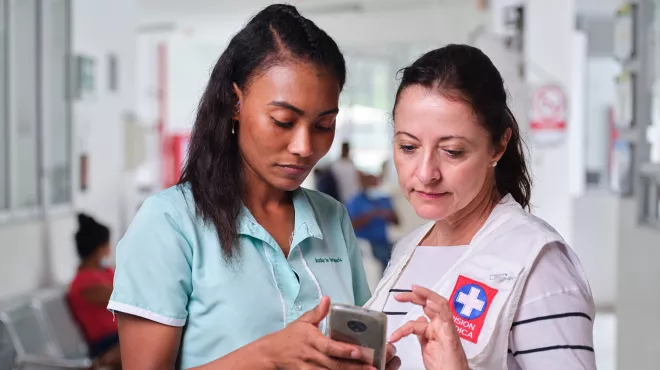Before joining Novartis, Jay Bradner was a cancer researcher and pioneer of the growing trend toward open scientific innovation. He believes that in science, more minds are better. The more people working on tough scientific puzzles, the more likely they will be to find solutions.
Now, as President of the Novartis Institutes for BioMedical Research (NIBR), he is applying this mindset to accelerate the process of drug discovery and development, an effort that takes good ideas from the lab and translates them into safe and effective medicines that fight disease.
Over the past two years, NIBR has launched a series of open science initiatives. These programs include a collaboration with researchers at the University of California, Berkeley, in the US to leverage a method they developed to find fresh ways to interrupt the cellular machinery that causes disease. Another effort invites academic researchers to work inside NIBR’s labs, creating a faculty of scholars at Novartis.
At the core of Bradner’s strategy is his conviction that open science is good not just for advancing medicine, but also for humanity and business.
Bradner speaks more about opening the framework of scientific research below:
Can you give an example of what open science looks like?

When I was at Dana-Farber, my lab discovered a way to keep cancer cells from remembering that they were cancer cells by using a molecule called JQ1 to induce a kind of cellular amnesia. I decided to share JQ1 with anyone who would take it. Hundreds of interested scientists studied the compound in their own labs to learn more about its effects on a range of forms of cancer. What we learned from this experiment is that by practicing more open science, we could dramatically expand our scientific bandwidth.
Similarly at Novartis, we’d like to share powerful molecules we discover in our labs so that we can learn as much about them as possible before moving forward with turning them into medicines.
Is it likely that other compounds will be as interesting or transferable as JQ1 was?
Yes, definitely. Would you believe that some of the most important medicines we have at Novartis were not innovated for the purpose they’re prescribed for today? Rather than cross our fingers and hope that the most important or effective application of a candidate drug is identified mid-stream, wouldn’t it be better to get out in front of this and put our compounds into the hands of the scientific community and really engage in collaborative, openly distributed research? This parallel approach is the shortest path to being able to deliver medicines to the patients first who need them most.
How will Novartis get a return on its investment in innovating molecules if other companies and labs get unfettered access to them?
Our ability to develop important medicines depends fundamentally on mechanistic clarity, which is expedited through open science. For example, at NIBR we have innovated the world’s first EED inhibitor. EED inhibition reverses changes to cancer cells that make them act like developmentally young, rapidly replicating cells. Nobody’s ever made an EED inhibitor before. Rather than lock this secret away until we’ve completed clinical trials, we made a decision to make the EED chemical probe broadly available to the scientific community. These data could help us compare the compound to other related epigenetic mechanisms.
It is an unmistakable good for the scientific community and for our appreciation of the natural world to make such a tool available, but it’s also very strategic. Typically, the distributed chemical probe is not the drug molecule. This is important. In open science, we relinquish a little bit of control – an amount appropriate for a prototype compound – to derive much more clarified guidance on how to develop a drug compound.
Can you describe another example of an open framework?
Data sciences and digital medicine figure prominently in our open framework strategy. The path to innovation in drug discovery stands to be disrupted by advances in computer science, notably advanced analytics and machine learning. We are not device manufacturers, and we get that, so we therefore aspire to be the best collaborator ever for people who are.
Is Novartis on the radar of investigators out there with interesting ideas or technologies?
I hope so. We intend to become the partner of choice to biomedical innovators. It’s important that the community recognizes that we are all ears. What people need to know is, No. 1, we are going to work as colleagues. And No. 2, we intend to support their science. Surely this has been the experience of our colleagues at the University of Pennsylvania and of many other collaborators. Novartis has a wonderful collaborative reputation and through a more open practice of science, we’ll be rightly regarded as a leading institution for open science.
If someone has a great idea, how do they connect with scientists at Novartis?
I suspect that today’s resourceful innovator would have no trouble identifying a relevant colleague here at Novartis given that we published over 770 scientific papers last year. Many of our innovators attend and contribute to major scientific and medical meetings. Additionally, we will soon recruit a Head of External Innovation, who will be a connector and portal of entry.
How does open science fit into the overall Novartis business strategy?
The business of Novartis is built on a foundation of medicines that really move the needle for patients. If NIBR, as a research institution, leverages open science to find medicines that deliver profound impact, there’s a business there. This impact does not relate to the number of people affected by a disease. Rather, it relates to the magnitude and duration of benefit provided to the patient. If we, as a research institution, optimize around impact, we can have a more successful business in the fullness of time. So here at NIBR we focus on impact. The impact of our science is greater when we join forces and work together.



